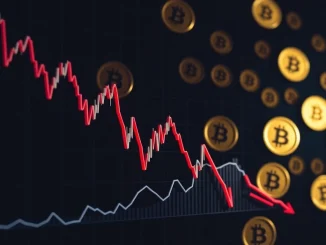
Buckle up, crypto enthusiasts! The market just witnessed a seismic event. If you blinked, you might have missed it, but the numbers are staggering. In just 60 minutes, a whopping $448 million worth of cryptocurrency futures positions were liquidated across major exchanges. Zooming out to the last 24 hours? That figure explodes to a colossal $1.329 billion. Let’s dive into what this means for you and the broader crypto landscape.
What Triggered This Massive Crypto Liquidation Event?
The crypto market is known for its volatility, but these numbers signal more than just a typical dip. A crypto liquidation event of this magnitude often points to a cascade effect, where a sudden price drop triggers a series of automated sell-offs. But what sets off that initial domino?
- Sudden Price Swings: The crypto market can be swayed by news, rumors, or even whale activity. A sharp downward movement in the price of Bitcoin or Ethereum, for instance, can trigger margin calls and subsequent liquidations.
- Market Over-Leverage: Futures trading allows traders to use leverage, amplifying both potential gains and losses. High leverage means even small price fluctuations can lead to liquidations, especially in a volatile market like crypto.
- External Economic Factors: Global economic news, regulatory announcements, or shifts in investor sentiment can all contribute to market downturns and liquidations.
While the exact trigger for this specific event is still being dissected, the sheer scale indicates a significant market correction was underway. Understanding these triggers is crucial for navigating the choppy waters of the crypto market.
Futures Market Frenzy: Why Liquidations Matter
If you’re new to crypto trading, especially futures, the term ‘liquidation’ might sound a bit abstract. But it’s a very real and impactful event, particularly in the high-stakes futures market. Here’s why liquidations are a big deal:
- For Traders: Liquidation means your position is forcibly closed by the exchange because you no longer have sufficient margin to keep it open. In simpler terms, you lose your initial investment on that trade.
- Market Volatility Amplifier: Large-scale liquidations can exacerbate market volatility. As positions are automatically closed, it can trigger further price drops, leading to a vicious cycle of liquidations and downward pressure.
- Indicator of Market Sentiment: A massive liquidation event can be a sign of fear and panic in the market. It suggests that many traders were caught off guard by the price movement and were over-leveraged.
Think of it like a domino effect. One significant price drop triggers liquidations, which pushes the price down further, causing more liquidations. This can create a rapid and dramatic market correction.
Exchange Liquidations Breakdown: Where Did the Bloodbath Occur?
Major cryptocurrency exchanges are the battlegrounds where these exchange liquidations unfold. While specific exchange data fluctuates in real-time, reports indicate that leading platforms bore the brunt of this liquidation event. Although detailed exchange-specific breakdowns require real-time data feeds, we can generally observe trends across prominent exchanges during such events.
Key Exchanges to Watch (Examples):
- Binance: Often the exchange with the highest trading volume, Binance typically sees a significant portion of liquidations during market downturns.
- OKX: Another major player, OKX, also experiences substantial liquidation volumes due to its large user base and futures trading activity.
- Bybit: Known for its derivatives trading, Bybit is frequently among the exchanges reporting high liquidation figures during periods of market turbulence.
- Other Major Exchanges: Platforms like Huobi, Kraken, and Coinbase (though less focused on high-leverage futures) also contribute to the overall liquidation numbers.
Keeping an eye on liquidation data from these major exchanges provides a clearer picture of market stress and the extent of trader losses.
Bitcoin Price Impact: The Bellwether Crypto Leads the Charge
Bitcoin price movements are often the primary driver of overall crypto market sentiment. When Bitcoin sneezes, the altcoin market catches a cold – and in this case, Bitcoin seemed to have caught a full-blown flu. Significant liquidations are frequently correlated with sharp price drops in Bitcoin, which then cascade through the rest of the crypto ecosystem.
Bitcoin’s Role in Liquidations:
- Market Dominance: Bitcoin’s dominance means its price action heavily influences the entire market. A Bitcoin price drop often triggers sell-offs in other cryptocurrencies.
- Liquidation Cascade Trigger: Bitcoin is frequently used as collateral in futures trading pairs. A sharp Bitcoin price decline can initiate margin calls and liquidations across various altcoin positions as well.
- Investor Sentiment Indicator: Bitcoin’s performance is often seen as a barometer of overall crypto market health. A significant drop can erode investor confidence and fuel further sell-offs.
While the data points to widespread liquidations across various cryptocurrencies, Bitcoin’s role as the leading cryptocurrency means its price fluctuations are often at the heart of these market-wide events.
Navigating Market Volatility: Actionable Insights for Crypto Traders
Large-scale market volatility events like this can be unnerving, but they also offer valuable lessons and opportunities for crypto traders. Here are some actionable insights to consider:
- Manage Leverage Wisely: High leverage can amplify gains, but it also dramatically increases risk. Consider reducing leverage, especially in volatile market conditions.
- Use Stop-Loss Orders: Stop-loss orders can automatically close your position if the price moves against you, limiting potential losses and preventing liquidation.
- Diversify Your Portfolio: Don’t put all your eggs in one basket. Diversifying across different cryptocurrencies and asset classes can help mitigate risk.
- Stay Informed and Adapt: Keep abreast of market news, economic indicators, and regulatory developments. Be prepared to adjust your trading strategy based on changing market conditions.
- Long-Term Perspective: Remember that crypto markets are cyclical. Volatility is inherent. Focus on the long-term potential of your investments and avoid panic selling during short-term downturns.
Market corrections, while painful in the short term, are a natural part of market cycles. They can even present opportunities to accumulate assets at lower prices for long-term growth.
Conclusion: Riding the Crypto Rollercoaster
The recent $448 million hourly and $1.329 billion 24-hour crypto futures liquidation event serves as a stark reminder of the inherent volatility in the cryptocurrency market. It highlights the risks associated with leveraged trading and the rapid shifts in market sentiment that can occur. While these events can be shocking, they are also a part of the crypto landscape.
For crypto traders and investors, understanding the dynamics of liquidations, managing risk effectively, and maintaining a long-term perspective are crucial for navigating this exciting yet unpredictable market. Stay informed, stay vigilant, and ride the crypto rollercoaster with your seatbelt securely fastened!



